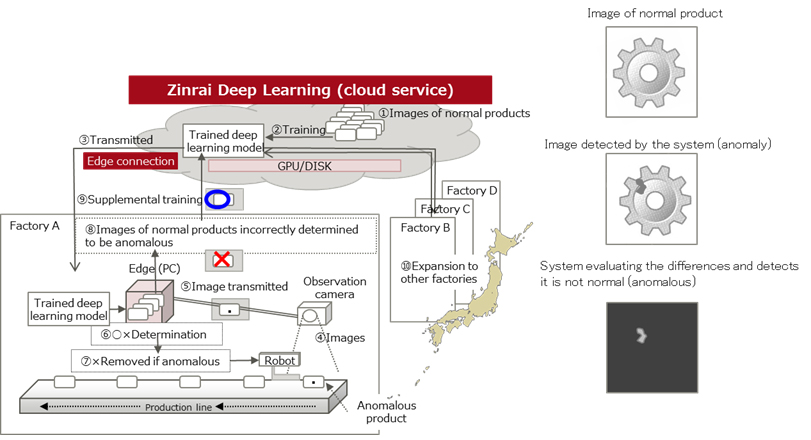
Fujitsu, announced that it has categorized specific artificial intelligence usage scenarios and introduced 17 offerings that indicate the optimal technology and solutions as well as the implementing effects of Fujitsu Human Centric AI Zinrai, in order to promote its use in a wide range of industries and businesses.
These offerings show cases of how AI can resolve issues, and propose Zinrai technology, products and services that would support such uses, based on a categorization of the various issues facing customers through the approximately 600 business deals relating to AI usage at Fujitsu. Moreover, these offerings predict the impact of deploying these products and services while estimating costs, enabling customers to more concretely envision the use of AI in their business and deploy solutions quickly and easily.
Fujitsu will expand the lineup of Zinrai technologies, products, as well as solutions going forward, and search for new usage scenarios across an even broader range of industries and businesses, supporting the customers’ digital transformations with the new offerings.
Details of these offerings will be introduced at Fujitsu Insight 2017 in Belle Salle Nihonbashi (Tokyo) on November 17.
Background
In November 2015, Fujitsu systematized its set of AI-related technologies, products, and services as Fujitsu Human Centric AI Zinrai, and since April 2017, has been offering products and services such as the Fujitsu Cloud Service K5 Zinrai Platform Service and the Fujitsu AI Solution Zinrai Deep Learning System. At the same time, Fujitsu has worked with customers in co-creation efforts and field trials due to numerous demands in utilizing AI.
Through these activities, Fujitsu received many questions from customers in a variety of industries, including manufacturing, retail, and finance, asking what they could achieve with AI, or whether their issues could be resolved with AI, or how much it would cost, in both time and money, to apply AI to a problem. This led the company to realize that customers had not specified scenarios in which they could utilize AI.
About the 17 Offerings
Over the course of approximately 600 business deals relating to the use of AI, Fujitsu has categorized the usage scenarios with particularly high demand, creating an initial total of 17 AI usage scenarios spread across seven different usage areas, including knowledge utilization and call centers. Moreover, Fujitsu will introduce Zinrai technologies, products, and services that will deliver on these scenarios while laying out the expected impact and estimated costs, thereby supporting the entire process from deployment to installation and operations with optimal AI usage for customers.
| Table1: Major offerings for the use of AI in business | |||
| Usage Area | Usage Scenario | Zinrai Technology | |
| Knowledge Utilization | Searching for related documents in research and development | Search through all related documents so that users will not miss or overlook necessary information | Domain specific semantic search |
| Call Center Inquiries | Automatic categorization of customer communications (voice of customer) | Automatically classify each communication from a customer (voice of customer), reducing manual labor hours and improving analysis systems | Natural language analysis |
| Work/Life | Supports suggestions that suit latent desires and interests | AI can provide matching that predicts user interests | Matching |
| Social Infrastructure | Supports visual inspection by experts | Supports inspection of social infrastructure Automates image inspection requiring expert knowledge |
Image recognition Deep learning |
| Maintenance | Supports worker safety management | Supports the creation of safe workplaces with remote monitoring of workers | Heat stress estimation algorithm Machine learning |
| Manufacturing | Product anomaly detection | Detects product anomalies using deep learning | Image recognition Deep learning |
| Digital Marketing | Effective use of video and audio data | Improved voice recognition rate by eliminating noise using deep learning | Deep learning |
Please click here to see the full list of the 17 offerings (90 KB/A4, 1 page)
- Usage Scenario 1: Finding and collating related materials in research and development
The API function (that search for meaning by area of specialization) of Zinrai automatically comb through large volumes of various documents to organize information, in order to efficiently search through large volumes of documents related to technical information without missing anything. As a result, for example, if a researcher or developer were to search for information using the name of a technology or a related keyword, the results will be displayed in the order of their relevance. In addition, by displaying results including similar research topics and related examples of failure, this solution can visualize the relationships between documents.
This system enables efficient and complete collection and organization of information, as compared to existing document search methods, which can lead to improved research and development output.
[Cost estimate] Initial expenses: 10 million yen+ (from deployment to verification)

- Usage Scenario 2: Recognizing product defects with deep learning
Customers primarily involved in manufacturing can use image recognition technology through the Fujitsu Cloud Service K5 Zinrai Platform Service Zinrai Deep Learning to standardize and increase the efficiency of the detection of anomalous products in production lines, as the system will be trained on images of normal products only and automatically detect defective products. In addition, by using the same, trained deep learning model in all factories, it becomes easy to ensure that the standard for anomaly detection is consistent, while the trained model can be continually improved through additional training on a variety of image data collected at each factory.
With this service, customers can achieve more consistent and improved product quality across all production lines, without spending time and money from manual labor.
[Cost estimate] Pre-deployment evaluation: 2 million yen+, full scale production deployment: by individual estimate



















